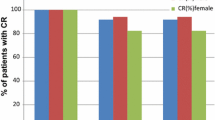Abstract
Background
Our aim was to evaluate the efficacy of oral aprepitant in rescue treatment after the primary rescue for breakthrough chemotherapy-induced nausea and vomiting (CINV) in chemotherapy-naive patients receiving moderately emetogenic chemotherapy (MEC).
Methods
This was a single-institutional phase 2 study. Patients who had received MEC regimens and developed breakthrough CINV despite antiemetic prophylaxis without aprepitant were treated with primary rescue antiemetic treatments chosen by physicians. When the primary rescue (1st rescue) failed, patients received oral aprepitant as the second rescue (2nd rescue). The primary endpoint of this study was the proportion of patients requiring aprepitant as the 2nd rescue and experiencing successful rescue (SR). SR was defined as no vomiting and no need for additional rescue therapy, with nausea up to grade 1 on Common Terminology Criteria for Adverse Events and a Visual Analog Scale score of 25 mm, for 48 h after initiation of aprepitant.
Results
Eighty patients were eligible for this analysis. Thirty-eight (47.5%) developed breakthrough emesis and received 1st rescue. The 1st rescue was ineffective in 29 (76.3%) patients, and they received the 2nd rescue with aprepitant. Thirteen of these 29 patients (16.3% of the total patients) satisfied the criteria for SR. The primary endpoint, SR rate, in patients treated with aprepitant, was 44.8% (95% confidence interval 26.4–64.4).
Conclusion
Since the lower end of the 95% confidence interval of SR is 26.4%, the SR in our study did not meet the predefined primary endpoint threshold. However, aprepitant was estimated to be useful in suppressing breakthrough CINV in 16% of the patients treated with MEC.

Similar content being viewed by others
References
Roila F et al (2010) Guideline update for MASCC and ESMO in the prevention of chemotherapy- and radiotherapy-induced nausea and vomiting: results of the Perugia consensus conference. Ann Oncol 21(Suppl 5):232–243. doi:10.1093/annonc/mdq194
Sun CC et al (2005) Rankings and symptom assessments of side effects from chemotherapy: insights from experienced patients with ovarian cancer. Support Care Cancer 13:219–227. doi:10.1007/s00520-004-0710-6
National Comprehensive Cancer Network (2017) NCCN Clinical practice guidelines in oncology-antiemesis_ver.2.2016, pp AE5–AE8
ASCO (2012) Annual Meeting Abstracts. J Clin Oncol, vol 30 15 suppl (May 20 Supplement) 9064
Navari RM, Nagy CK, Gray SE (2013) The use of olanzapine versus metoclopramide for the treatment of breakthrough chemotherapy-induced nausea and vomiting in patients receiving highly emetogenic chemotherapy. Support Care Cancer 21:1655–1663. doi:10.1007/s00520-012-1710-6
Jordan K, Sippel C, Schmoll HJ (2007) Guidelines for antiemetic treatment of chemotherapy-induced nausea and vomiting: past, present, and future recommendations. Oncologist 12:1143–1150. doi:10.1634/theoncologist.12-9-1143
Warr DG et al (2005) Efficacy and tolerability of aprepitant for the prevention of chemotherapy-induced nausea and vomiting in patients with breast cancer after moderately emetogenic chemotherapy. J Clin Oncol 23:2822–2830. doi:10.1200/jco.2005.09.050
Rapoport BL et al (2010) Aprepitant for the prevention of chemotherapy-induced nausea and vomiting associated with a broad range of moderately emetogenic chemotherapies and tumor types: a randomized, double-blind study. Support Care Cancer 18:423–431. doi:10.1007/s00520-009-0680-9
Tanioka M et al (2013) A randomised, placebo-controlled, double-blind study of aprepitant in nondrinking women younger than 70 years receiving moderately emetogenic chemotherapy. Br J Cancer 109:859–865. doi:10.1038/bjc.2013.400
Acknowledgements
We wish to thank the timely help given by Ms. Kumiko Sumiyama and Ms. Mami Higuchi in arranging the large number of samples.
Author information
Authors and Affiliations
Corresponding author
Ethics declarations
Conflict of interest
The authors declare that they have no conflict of interest.
About this article
Cite this article
Inoue, T., Kimura, M., Uchida, J. et al. Aprepitant for the treatment of breakthrough chemotherapy-induced nausea and vomiting in patients receiving moderately emetogenic chemotherapy. Int J Clin Oncol 22, 600–604 (2017). https://doi.org/10.1007/s10147-016-1081-y
Received:
Accepted:
Published:
Issue Date:
DOI: https://doi.org/10.1007/s10147-016-1081-y




